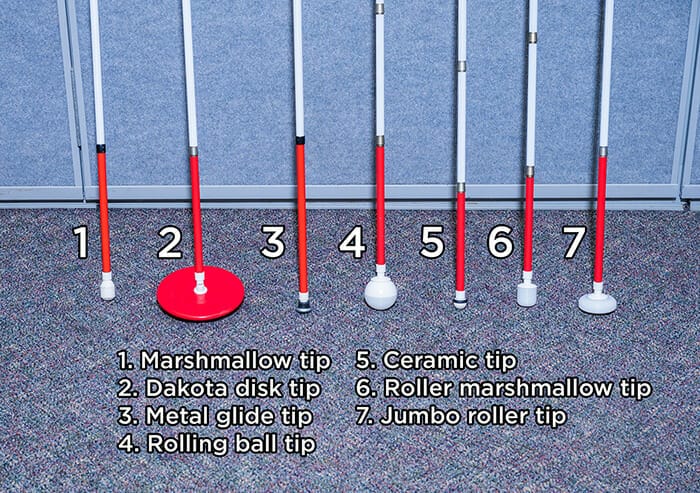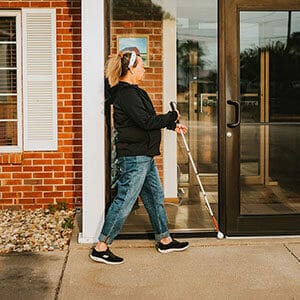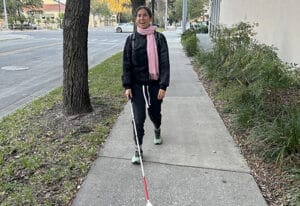Summary
For people who are blind, choosing a white cane can be a daunting task when you don’t know where to start. You may not know who to reach out to, where to buy it, type of shaft, what size to get, and even what cane tip. So, let’s start there: what do all those even mean? Canes come in all shapes and sizes, but do the differences affect my travel? How do I select the best cane for my size, gait and environment? Certified Orientation and Mobility Instructor at Leader Dogs for the Blind Brad Welling provides an overview of different types canes and how to select them.

My name is Brad Welling, and I am one of the certified orientation and mobility specialists (COMS) here at Leader Dog. I’m originally from the Kalamazoo area in Michigan where I attended Western Michigan University. I graduated from WMU with an undergraduate degree along with a master’s in orientation and mobility. While attending WMU I came to Leader Dog for one week to gain some real-world experience. As I went on to finish my degree, I remembered the great environment here at Leader Dog. After I graduated, when I saw that Leader Dog was hiring, I knew I had to go back.
Choosing a cane can be a daunting task when you don’t know where to start. I know when I had to get a cane for school, I had a hard time picking one out. I didn’t know who to reach out to, where to buy it, type of shaft, what size to get, and even what cane tip. When I finally did get my cane, I just got what was in stock at the accessibility resource center. I ended up buying a 58” inch rigid cane with a fixed marshmallow tip. So, let’s start there: what does that even mean? Canes come in all shapes and sizes, but do the differences affect my travel?
First, you have the material the cane is made of: some of these materials are graphite, aluminum and fiberglass. These differ with strength, flexibility and weight. When it comes to the cane shaft there are a couple options. The cane I bought is rigid, which means the shaft is one solid piece of material. Folding canes, as the name implies, will fold down to a smaller size for easier carrying and storage. They can have four, five or six segments. Lastly, we have collapsing canes, which are telescopic canes. Folding canes are handy; you can be using it and the moment you do not need it you can fold it up and hold on to it, put it in a bag or set it down somewhere. Rigid canes can be somewhat cumbersome due to their length, but they make up for it with their sensitivity to the environment. Collapsing canes can be portable, but they tend to collapse whenever encountering uneven terrain.

Canes can differ in their length. Cane length changes for everybody based on a lot of different variables, such as height, walking speed, preference, reaction time and use. With these in consideration, cane length tends to range from the height of a person’s sternum up to the chin. Some people even use canes that are taller than they are! In school we were taught that the cane length should be at the top of the sternum and possibly a little longer if requested. However, I tend to lean more toward the longer cane size with it being two to four inches above the sternum. This depends on the person. If the person doesn’t have the strength or mobility to move a longer/heavier cane, or the pace needed for a longer cane, then a short cane can be best. In my case I have a fast pace and a longer stride, so a longer cane works for me.
 There are numerous cane manufacturers, but I want to focus on two big brands in the cane world: NFB (National Federation of the Blind) and Ambutech. NFB are primarily known for being one type, which are long rigid canes that are extremely light and flexible. They typically come with one tip option, the metal glide tip, which is fixed in place. Ambutech makes and sells many different types of canes. They tend to be a little heavier than NFB canes, but they make up for it with versatility. Many Ambutech canes have a bungee cord that goes through the center of the cane, this lets the cane have interchangeable cane tips. Ambutech canes come in both rigid (one solid piece) or folding.
There are numerous cane manufacturers, but I want to focus on two big brands in the cane world: NFB (National Federation of the Blind) and Ambutech. NFB are primarily known for being one type, which are long rigid canes that are extremely light and flexible. They typically come with one tip option, the metal glide tip, which is fixed in place. Ambutech makes and sells many different types of canes. They tend to be a little heavier than NFB canes, but they make up for it with versatility. Many Ambutech canes have a bungee cord that goes through the center of the cane, this lets the cane have interchangeable cane tips. Ambutech canes come in both rigid (one solid piece) or folding.
The National Federation of the Blind has a program that gives out one free cane every six months for people that meet their requirements of being visually impaired. You can view the National Federation of the Blind free cane program here. Ambutech canes can be purchased online through their website with a variety of pricing. Selecting the right cane brand, material, size and type is just half of the battle when finding the perfect match. Selecting the right cane tip is half the battle, and one that will be discussed at great length in an upcoming blog post.
If you’re curious about what orientation and mobility really is and how it works for people who are blind, you can find out more in our post “What is Orientation and Mobility?“
If you’re in need of Orientation and Mobility training, Leader Dog can help! Whether you’re brand new to working with a cane, an experienced cane traveler, or looking to brush up skills in preparation for a guide dog, we can customize our program for you. O&M at Leader Dog is free and you do not need to plan to get a guide dog to qualify. Discover more about our O&M program.



